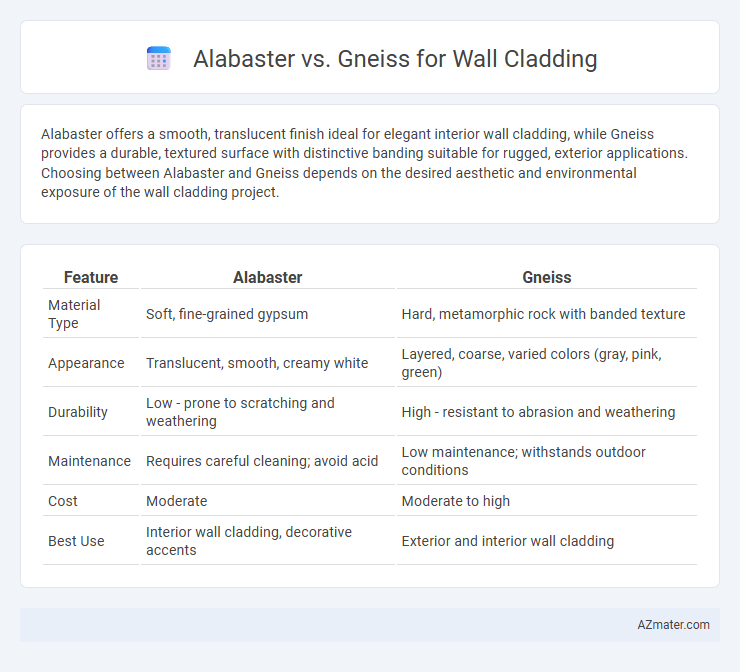Alabaster offers a smooth, translucent finish ideal for elegant interior wall cladding, while Gneiss provides a durable, textured surface with distinctive banding suitable for rugged, exterior applications. Choosing between Alabaster and Gneiss depends on the desired aesthetic and environmental exposure of the wall cladding project.
Table of Comparison
| Feature | Alabaster | Gneiss |
|---|---|---|
| Material Type | Soft, fine-grained gypsum | Hard, metamorphic rock with banded texture |
| Appearance | Translucent, smooth, creamy white | Layered, coarse, varied colors (gray, pink, green) |
| Durability | Low - prone to scratching and weathering | High - resistant to abrasion and weathering |
| Maintenance | Requires careful cleaning; avoid acid | Low maintenance; withstands outdoor conditions |
| Cost | Moderate | Moderate to high |
| Best Use | Interior wall cladding, decorative accents | Exterior and interior wall cladding |
Introduction to Alabaster and Gneiss
Alabaster, a fine-grained, translucent form of gypsum or calcite, is prized for its smooth texture and warm, luminous appearance, making it a popular choice for elegant wall cladding. Gneiss, a durable, coarse-grained metamorphic rock characterized by its distinct banding and mineral composition including quartz, feldspar, and mica, offers a robust and visually striking option for exterior and interior cladding projects. Their contrasting properties in texture, hardness, and aesthetic appeal make alabaster suitable for delicate, decorative applications, while gneiss provides strength and natural patterns ideal for more rugged wall surfaces.
Geological Composition and Formation
Alabaster, primarily composed of gypsum or calcite, forms through the evaporation of mineral-rich waters in sedimentary environments, resulting in a soft, fine-grained texture ideal for detailed carvings but less durable for exterior wall cladding. Gneiss, a high-grade metamorphic rock characterized by its banded appearance, originates from the intense heat and pressure transformation of granite or sedimentary rock, creating a hard, dense material with excellent resistance to weathering. The significant difference in mineral composition and formation processes directly influences their suitability; alabaster offers aesthetic translucency, while gneiss provides structural strength and longevity for wall cladding applications.
Aesthetic Appeal and Color Variations
Alabaster offers a translucent, smooth surface with soft, creamy white tones that create a luxurious and elegant aesthetic appeal for wall cladding, often enhancing light reflection in interior spaces. Gneiss features a more textured, banded appearance with a dynamic mix of earth tones, including grays, blacks, and rusty reds, providing a natural, rugged look that adds depth and visual interest. Color variations in alabaster are subtle and uniform, while gneiss showcases pronounced contrast and intricate patterns, making each stone unique for architectural applications.
Durability and Strength for Wall Cladding
Alabaster, a soft and translucent sedimentary stone, lacks the durability and strength required for exterior wall cladding, making it prone to scratching, weathering, and erosion over time. Gneiss, a metamorphic rock characterized by its high compressive strength and resistance to weathering, provides superior durability and structural integrity for both interior and exterior wall cladding applications. The mineral composition and foliated texture of gneiss contribute to its robustness, ensuring long-lasting performance in harsh environmental conditions compared to the fragile nature of alabaster.
Water and Stain Resistance Properties
Alabaster, a soft and porous metamorphic stone, exhibits low water and stain resistance, making it less suitable for wall cladding in high-moisture environments. Gneiss, characterized by its dense, foliated structure and quartz-feldspar composition, offers superior water and stain resistance, enhancing durability and ease of maintenance for exterior and interior wall cladding applications. The inherent mineral composition and low porosity of gneiss provide a robust barrier against water infiltration and surface staining compared to alabaster.
Installation Process and Techniques
Alabaster wall cladding requires careful handling due to its delicate, translucent nature and softness, often necessitating adhesive bonding or mechanical fixing with non-invasive clips to prevent cracking. Gneiss, being a durable and dense metamorphic rock, supports traditional installation methods like mortar or mechanical anchors, offering greater flexibility in panel size and weight handling. Precision cutting and sealing are essential for both materials to ensure longevity and resistance to environmental elements.
Maintenance and Care Requirements
Alabaster wall cladding requires gentle cleaning with a soft cloth and pH-neutral cleaners to prevent etching and discoloration due to its softness and porosity. Gneiss, being a hard, durable metamorphic rock, demands less frequent maintenance and withstands harsh cleaning products without damage. Regular sealing enhances the longevity of both materials, but gneiss offers superior resistance to stains and scratches, reducing overall upkeep efforts.
Cost Comparison: Alabaster vs Gneiss
Alabaster wall cladding generally costs more per square foot than gneiss due to its softer, more delicate nature requiring careful handling and installation. Gneiss offers a more cost-effective alternative with higher durability, resulting in lower maintenance expenses over time. The initial investment for gneiss is typically offset by its long lifespan and resistance to weathering, making it a preferred choice for budget-conscious projects.
Environmental Impact and Sustainability
Alabaster, a soft sedimentary rock, generally requires less energy to quarry and process compared to Gneiss, a hard metamorphic rock, resulting in a lower carbon footprint. Gneiss offers superior durability and weather resistance, reducing the need for frequent replacement and minimizing long-term environmental impact. Sustainable sourcing practices and local availability further influence the overall environmental footprint of both materials in wall cladding applications.
Best Applications and Design Recommendations
Alabaster, with its translucent quality and soft, milky appearance, is best suited for interior wall cladding in spaces that benefit from ambient light diffusion, such as backlit feature walls in luxury residential or hospitality settings. Gneiss, characterized by its durability and bold, banded texture, excels in both interior and exterior applications where robustness and natural stone aesthetics are desired, including accent walls and facades in commercial or high-traffic areas. Designers should leverage alabaster's ethereal glow for creating elegant, subtle light effects while opting for gneiss to bring dramatic, earthy patterns that enhance architectural statements and withstand environmental wear.

Infographic: Alabaster vs Gneiss for Wall Cladding
 azmater.com
azmater.com